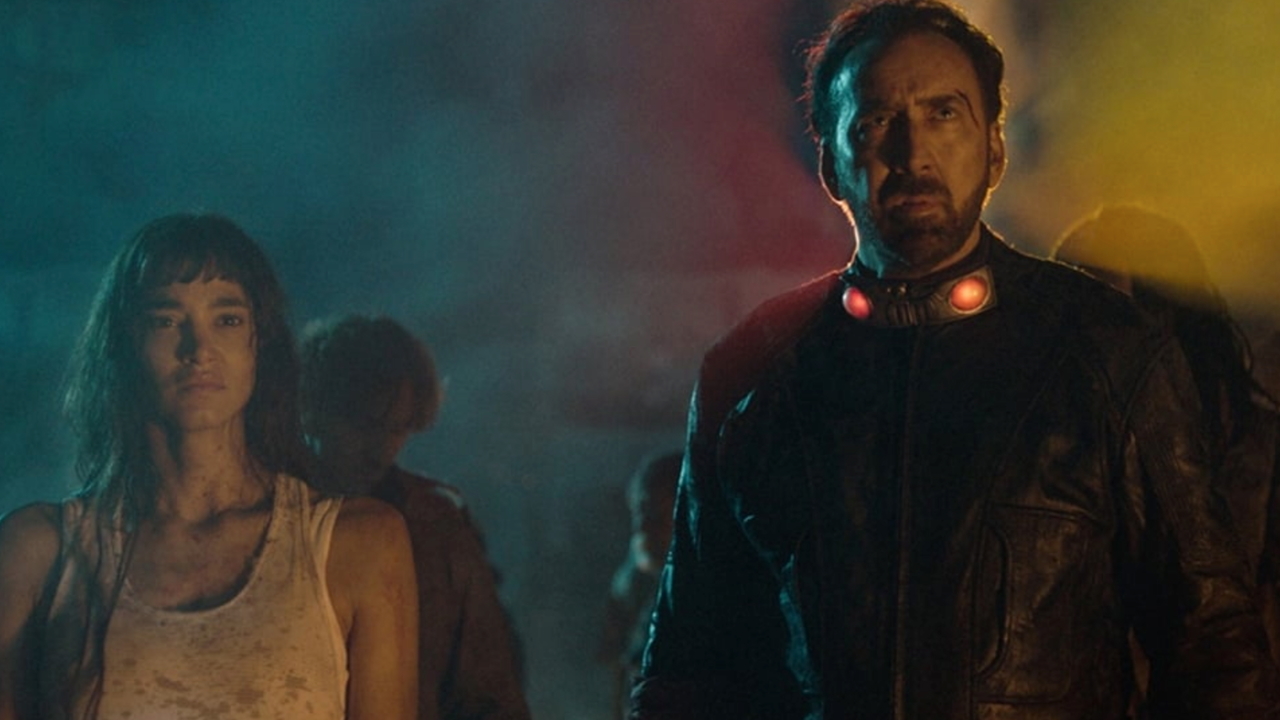
Prisoners of the Ghostland wastes no time engaging viewers with its opening scene depicting the curious contrast of the stark white interior of a bank with its many patrons donned in bright vibrant solid colors. Seconds later, Nicolas Cage, as our lead simply dubbed Hero, bursts through the front door clad in black and wielding a shotgun, immediately commanding both the scene and the viewers’ attention. Dripping with lush visuals from the very first frame, viewers will come to find the film to be the absolute height of spectacle at every level. The film instantly slams the gas pedal to top speed and rarely lets up aside from some needed moments of exposition.
The film follows Hero in the wake of this opening bank robbery. Imprisoned in Samurai Town at the mercy of its fast-talking ruler The Governor (Bill Moseley), he finds himself released to undertake a job hunting down the Governor’s wayward granddaughter Bernice (Sofia Boutella) who has allegedly become stuck in the titular Ghostland. This is a place spoken of by the townsfolk with fear, claiming it to be a cursed and haunted region from which no one can escape. To ensure his compliance, Hero gets strapped into a tight black leather suit rigged with explosives around various parts of his body. One on each arm, tied to a neurosensor that can read his intentions and activate a warning countdown should he try to harm an innocent woman like Bernice. Two at his crotch with the same setup to activate should he happen to take towards any impure thoughts after rescuing his target. Finally, two at his neck will eventually explode on a timer if the job is not completed within sufficient time. It is a madcap and crazy concept, but it is also the sort of movie magic that only director Sion Sono can deliver.
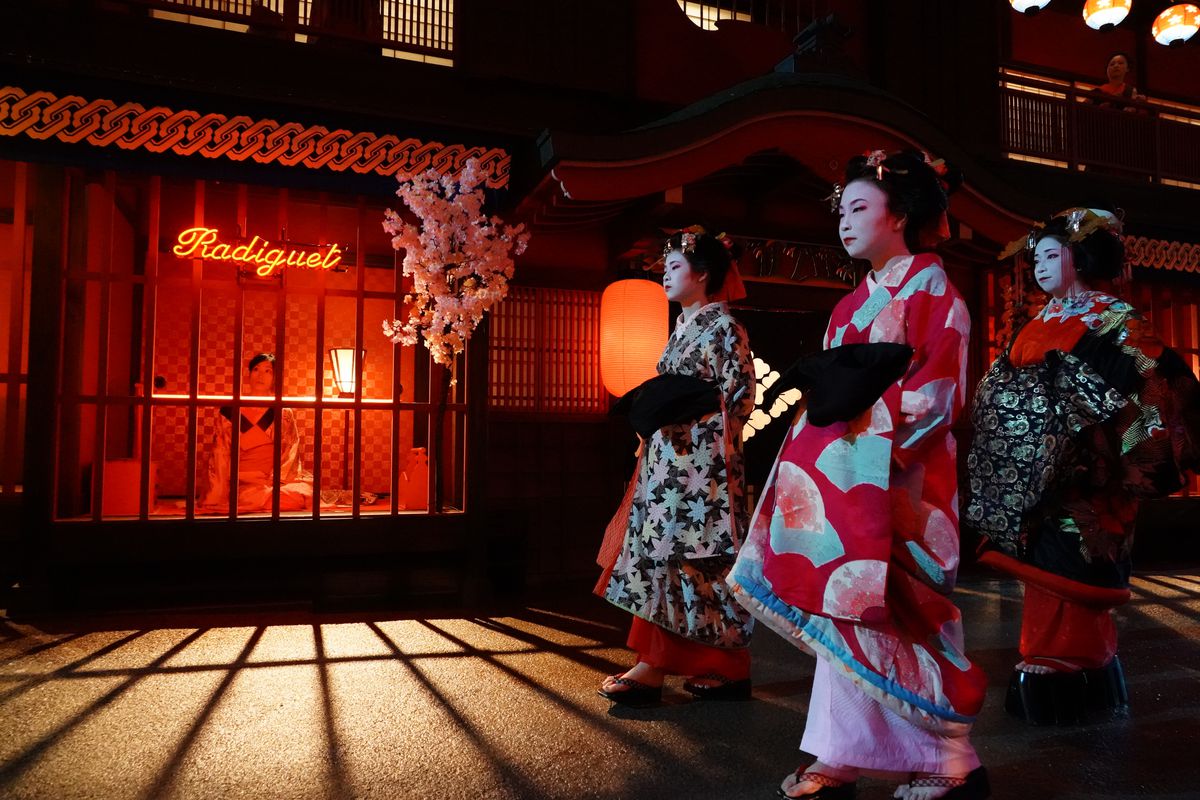
Sono is a master of filmmaking that deserves to be a common name in cinema the world over. Certainly, fans of Japanese movies will have encountered his works. Having directed nearly forty films through his career, Sono has an incredibly prolific output covering a wide range of genres and styles. From brutally gory horror flicks like Cold Fish to more subdued and thoughtful arthouse works like The Whispering Star, Sono stands well among other titans in the Japanese film industry like Takashi Miike for being incredibly adaptable and diverse with the palette they can use to craft both powerful and entertaining cinema.
He is also a very arresting director for those experiencing his talents for the first time. Considered highly subversive, there is a frantic energy that fuels many of his films, perhaps best exemplified by his early international breakout hit Suicide Club, often confronting the viewer with uncomfortable topics forcing them to face and consider these ideas whether they want to or not. It all has a very punk rock spirit to it that I adore endlessly, but it is not for everyone and when you go down the rabbit hole of discussions on Sono’s films you will find them to have staunch defenders and passionately angry detractors in equal measure. For sake of clarity in this review, I fall diehard into the former camp.
To me, the curious power that strikes me about his films is his ability to synthesize the trappings of a genre, or even the traits of select filmmakers, and somehow wholly capture their feel while still working it into something entirely unique with his own trademark style stamped upon it. When you watch The Whispering Star, you can feel the influence of Andrei Tarkovsky. The bombastic pacing and large-scale showdown in Why Don’t You Play in Hell? has readily been compared to Tarantino efforts like Kill Bill by critics. Even his original independent stab at an American movie Hazard, which is sorely overlooked and needs way more love than it gets, does its very best to channel the spirit of Martin Scorsese’s New York. It is evident to anyone working through Sono’s filmography that he is a true cinephile that champions his inspirations proudly. Yet, his works are never simple derivatives. Instead, these influences serve as building blocks along with his own creative ideas to make something greater as a whole.
Likewise, as his first proper English language movie, Prisoners of the Ghostland carries on this tradition but stabs at something new the director has yet to tackle. The broad premise of the central plot hits very close to home with John Carpenter’s Escape From New York. With its deserted wastelands and wildly dressed raiders, the film often draws to mind the boom of post-apocalyptic cinema that rose to prominence across the 70s and 80s with films like Mad Max. Samurai Town itself stands as a odd mixture of feudal Japan paired with the American old west, allowing the film to readily play with the key elements that overlap between both genres. Such a pairing will likely bring to mind Sukiyaki Western Django for Miike devotees, but Ghostland goes the extra mile distancing itself from being too similar with its additional post-apocalyptic flair. All these elements are hurled into the blender and worked into a radioactive fever dream that stands wholly alone and poised to offer viewers an experience they have never had before.
To bring to life such a crazy concept, I can think of no better person fit for the leading role than Cage. The day the film got announced, I could not help but think that Sion Sono working with Nicolas Cage sounded like a match made in heaven. Your own personal feelings about Cage’s acting will likely inform a bit of how you take the film. For every stellar hit, most people can point to another bomb somewhere in his career. However, in the past few years, there has been a veritable renaissance of hard-hitting amazing genre flicks all helmed by Cage in the leading role. If you’ve been ignoring anything the actor does due to prior failures at the box office, then chances are you have been missing out.
I have my own personal theory about all this. I think Nicolas Cage is an incredibly talented actor who brings so much energy and a unique presence to his performances. However, the end result to me rests a lot with the director. A director who understands and is able to work with and channel that energy properly will lead to something that is overwhelmingly incredible such as Panos Cosmatos’ Mandy; which is arguably one of the films spearheading that Cage renaissance. In the wrong hands, you wind up with movies that have become the butt of every joke like 2006’s unfortunate Wicker Man remake. I have seen too many films where Cage utterly commands the screen to think otherwise. Sono, naturally, is able to draw out the very best from his performance.
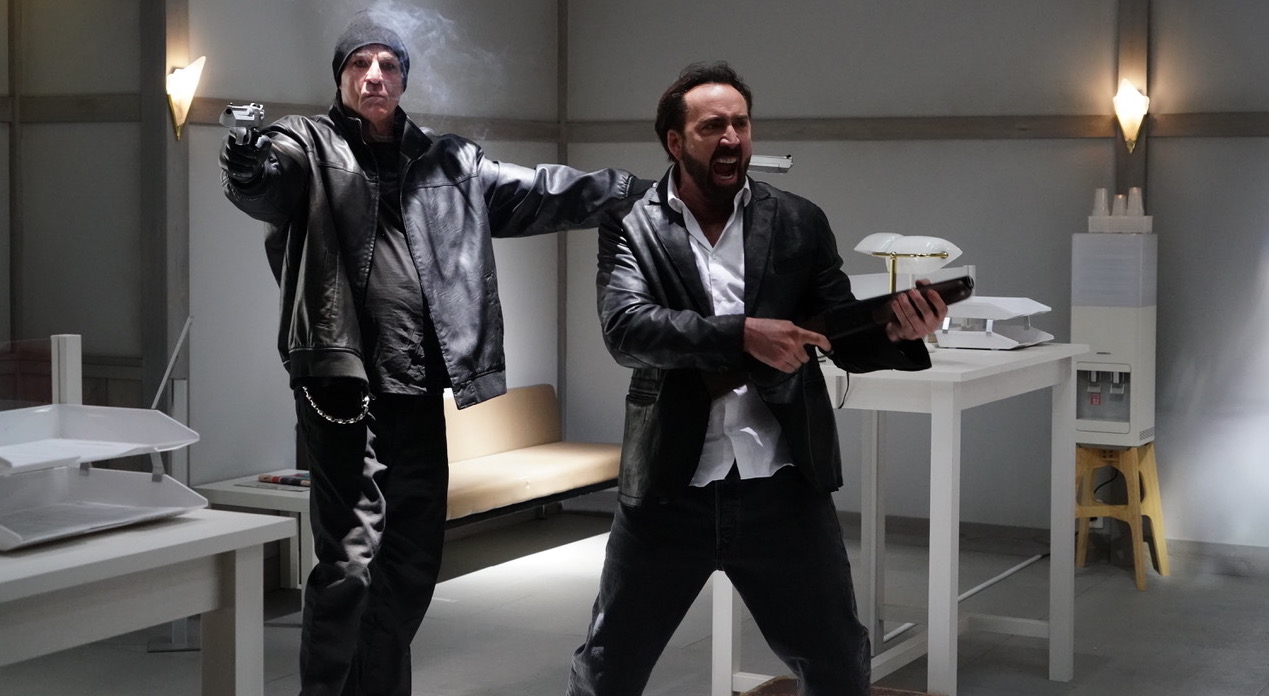
While he never ramps up to Vampire’s Kiss levels of strangeness, Cage manages to deliver so much fun as Hero. He is at once the stoic badass you would expect for this type of story while also having a strange childish charm. In preparation for his mission, The Governor supplies Hero with a sleek black car to zoom through the ruined wastes. However, he is quick to refuse the offer and instead steal someone’s bike and pedal away goofily instead. There are several moments like this where Hero makes rather oddball choices adding some enjoyable quirks to what might otherwise be a very dry character. Then of course there is the setup with his explosive suit. It does not take long into the film before Hero gets just a little too excited and winds up arming a bomb which ends up blowing off one of his testicles. A fact that he eagerly shouts at a huge crowd when recounting the trials and tribulations he has gone through over his journey. But there is also some nuance to the character as well. We see a lot of remorse for his past crimes and it is this feeling of guilt that ultimately drives his decisions making him truly worthy of bearing the name Hero in the end.
That is not to say that Cage alone is responsible for the film’s success. The entire cast is jam-packed with so many amazingly talented stars and genre veterans that it is hard not to geek out seeing them firing on all cylinders, each one giving amazing performances. Sofia Boutella’s Bernice anchors the other end of the story giving a subtle performance, allowing the character to breathe as an equal hero in the story and not just a damsel in distress waiting to be saved. Bill Moseley’s Governor is about what most would want to expect from the actor in this sort of role. He makes a great sinister villain easily launching into grandstanding and overbearing monologues that give some laughs among all the chaos. Nick Cassavetes returns to work alongside Cage for the first time since 1997’s Face/Off as Hero’s wayward and far more cruel partner in crime Psycho. That fact alone is such a fun bit of geeky film trivia.
Much of the supporting roles are unsurprisingly filled with collaborators from Sono’s other films. Those who have gone deep with his filmography will realize the director has a penchant to reuse performers that he has found particularly effective. This is the case here as well, including Tak Sakaguchi, Yuzuka Nakaya, YOUNG DAIS, Lorena Koto, and Jai West among so many others. It winds up being a cavalcade of Sono veterans befitting the spectacle of his first English language movie. I was a personal fan of DAIS’ character Ratman who leads a band of typical-looking wasteland scavengers obsessed with trying to rebuild things. They have some amazingly outlandish costuming going on and it was cool seeing their little group surrounded by vibrant dekotora style trucks which they had restored.
Tak Sakaguchi’s character Yasujiro deserves some particular highlighting as well. He serves as The Governor’s personal bodyguard summoning up the style of Kurosawa’s classic Yojimbo. Not simply a lone drifter, The Governor has a special hold over the swordsman ensuring his services. True to the spirit of classic samurai epics and the many spaghetti westerns they inspired, from the start we know that he will have an eventual showdown with Hero even though their goals might align more closely than they initially realize. It is not until late in the film when they finally go at it and the two deliver an epic duel that caps off the final set-piece.
I have tried to avoid going too deep with the plot because this is an experience that will reward you the less you know going in. There are a lot of interesting ideas mixed in among all the action. The Ghostland itself and the various unique properties it holds, along with the truth behind its creation, weaves a compelling story about the horrors of corporate greed and misuse of nuclear energy. It is nothing new, but at the same time, it is just a little sad how relevant it all still is today. There is an interesting theme regarding time as a concept, its passage, and how we can become all too easily enslaved and trapped by it. Even the rather straightforward narrative gets muddied with later revelations that call into question the timeline of events. And of course, there is just a little bit of dysfunctional family drama, a Sono mainstay in many of his films. The messages are overt and shouted at the audience as if through a megaphone. This is highlighted best when Bernice defiantly shouts “I am not a prisoner” early on, but it fits the bombastic tone of the film.
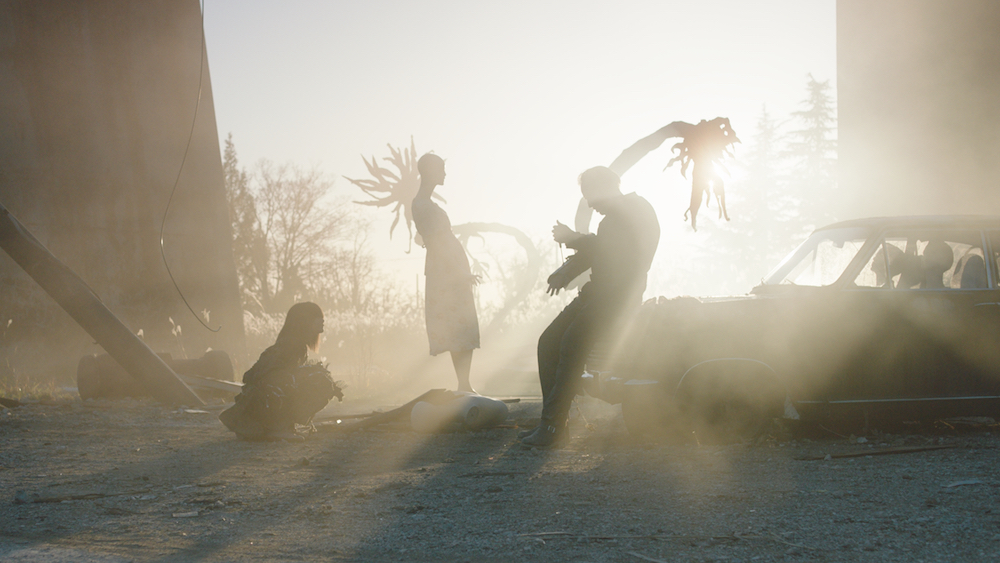
On a technical level, it is everything one might expect. The visuals are always interesting either by captivating use of color or interesting camera angles and compelling framing for scenes. There are plenty of strange moments visually as well. I particularly enjoyed some of the more surreal moments such as the rows of desks with open books clustered in the outskirts of the Ghostland. It is one of those odd moments that never gets explained and will just stick with you as something striking yet curious. The score, composed by Joseph Trapanese, manages to supplement the experience well. Several tracks effortlessly capture the spirit of classic spaghetti western flicks and when one of these themes kick in, they add so much weight and power to the moment.
Prisoners of the Ghostland is a true genre-blending masterpiece that needs to be experienced by all those who champion the spirit of the midnight movie. It is quirky, strange, and wears its inspirations on its sleeve, but the film manages to deliver a wildly fun time that doesn’t waste a second of its screen time. For those soaring high with love for Cage’s recent genre outings, take heart that this is very much so the next great entry on this wild ride. Veterans of Sono’s works should go in expecting it to fall in line with his more straightforward films where the focus is on the fun and the spectacle. Those expecting a layered, deeply complex tale like Noriko’s Dinner Table, which feels almost at times like a lengthy novel given life on the screen, may find the film lacking. The movie also makes an excellent jumping-off point for newcomers as well. If you dig the experience then you are sure to keep finding more enjoyment through exploring his other works.
Whether complex arthouse or overflowing with buckets of blood, the films of Sion Sono always manage to capture a deep love of cinema while delivering an overwhelmingly enjoyable experience, and this movie is no exception.
Prisoners of the Ghostland was screened as part of the 2021 Fantasia Film Festival. The festival runs virtually from Aug. 5 – 25, 2021.
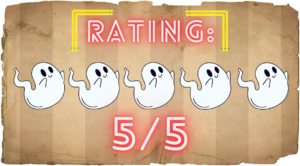
More from Fantasia Film Festival:
Confessions of a Serial Killer is a 1985 American horror thriller, written and directed by Mark Blair. Surprisingly, the film is the only writer/director credit to Mark’s name, never venturing… I first saw Alejandro Jodorowsky’s surreal, bildungsroman film, Santa Sangre, in 1989 on VHS tape. Watching it was like watching a slasher about a killer with a twisted Oedipal Complex… Born in 1946, Hideshi Hino stands out as a prominent Japanese horror artist, dedicating the majority of his life to conjuring various nightmares for his audience. Regrettably, in the Western… Panorama of Hell is a 1984 Japanese horror one-shot manga, written and illustrated by Hideshi Hino. Known as a master horror mangaka, Hino is most notable as the writer/illustrator for… Hey Mike Flanagan, we’ve found your next big project! New indie horror authors are crawling out of the woodwork every week, and just like indie films, their products are hit… Thine Ears Shall Bleed is a 2024 American period horror, written and directed by Ben Bigelow, with additional writing from William Bigelow. Previously working as writer and director of the… Regarded by many as Japan’s answer to Brigitte Bardot — both for her glamorousness and vaguely European looks (she wasn’t actually mixed-race) — Mari Atsumi became one of Japanese… Well-known in the extreme cinema community, Brian Paulin is a writer/director/editor/actor/key make-up effects artist for the film production company Morbid Visions in addition to playing guitar, drums, and singing for… In today’s world of flashy graphics and CGI, audiences have become immune to fantastical horror, pushing some writers to create content to test our boundaries with the extreme. In The… The femme fatale is one of the most compelling and enduring archetypes in film history, captivating audiences with their blend of beauty, mystery, and danger. These enigmatic women are uniquely…
Dustin is a potentially overqualified office worker who has a lifelong love and fascination with Japan and all things Horror. With a bachelor’s in English Literature and a master’s in Library Science, he devotes way too much time to researching and thinking critically about the media he enjoys. When not celebrating trashy horror films, anime, and idol music, he can be found raving about all things genre cinema as a co-host on Genre Exposure: A Film Podcast or indulging a passion for storytelling through tabletop roleplaying games.